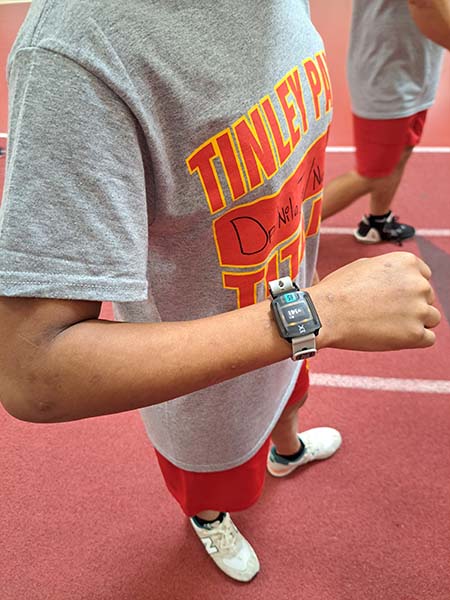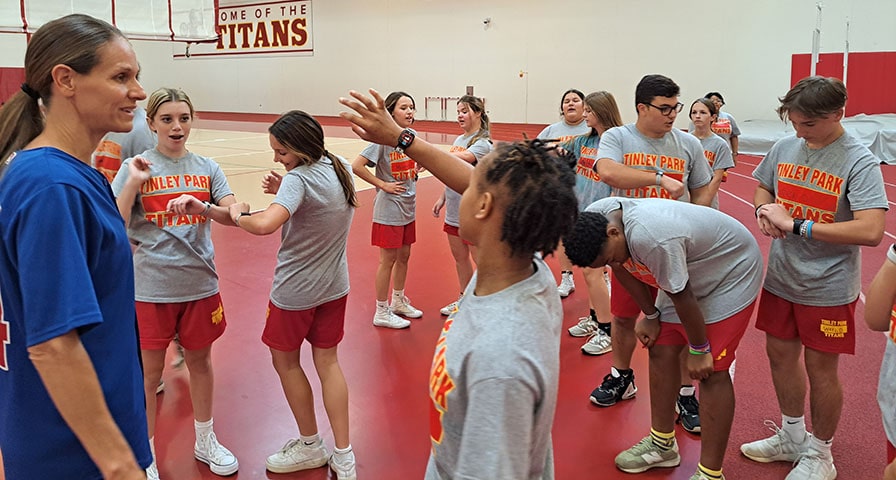
Bremen High School District Expands Initial Pilot Program Using ESSA and ESSER Funding to Put IHT ZONE Monitors in Every High School PE Class
Four IHT ZONE heart rate monitors, won at a past Illinois AHPERD conference, changed the way a school district handled its student wellness program, starting with its physical education classes.
Bremen High School District 228 sent a contingent of teachers to the state’s annual conference of health and PE teachers. One of them, Gus Yiakos, attended IHT’s session at the 2019 conference and entered a raffle for a set of 4 heart rate monitors. He won, brought the monitors back to campus and began a pilot program with a handful of students.
“He was using them and told me, ‘these are super cool….can I share these with the department at a meeting?’” Bremen Curriculum Supervisor for Health, Driver’s Ed and PE Terri Schrishuhn recalled recently.
Schrishuhn watched the presentation and immediately saw two things that she really liked:
“First the technology allowed teachers to deliver valuable lessons, and second it eliminated the chest strap,” she said.
Being a wrist-based monitor, the IHT ZONE eliminated that challenge for her teachers and students. That aspect, along with the feedback from her early-adopting teachers, convinced her to order sets for her teachers.
Using Federal Grants to Invest In IHT’s Heart Rate Program
“At that point we had some (Every Student Succeeds Act) Title 4 money and that allowed us to get a limited number of sets,” she said. “We were able to get 8 sets for our high schools and put 2 sets at each campus.”
Bremen’s high school PE team used the heart rate monitors for a year before COVID put on-campus learning on hold for the next 12-18 months. As schools returned to in-person learning, Schrishuhn learned about the Elementary and Secondary School Emergency Relief (ESSER) money that the federal government made available.
“We went from having 2 classroom sets in each (high school) building to now we have 28 sets and every teacher has their own,” she said.
Schrishuhn worked with her direct supervisor, who manages the district’s funding procedure, to request – and receive – federal funding.
“I’m very fortunate with the role I’m in,” she said. “My immediate supervisor, who is the assistant superintendent for teaching and learning, also manages the majority of the district’s grants. She knew the ins and outs of the grant so we could maximize the funding efforts. One of the areas of focus under ESSER was to improve the quality of learning through the use of digital tools.
“She said ‘if this is something you need then let’s write that in the grant,’” Schrishuhn said. “All of our monitors have been purchased with grant money.”
Maximizing the Investment with Cross-Curricular Use
Schrishuhn maximized the dollars she sought through both ESSA and ESSER by explaining the cross-curricular way her teachers used the monitors and the data students received from them. Each time students wear the monitors, they receive an email summarizing their activity while wearing them. The email offers students the chance to reflect on how they felt during – and after – their session. Many schools – Bremen included – use this as an opportunity to link heart rate to writing or ELA classes.
Along with PE classes, Bremen also uses the heart rate monitors for students to focus on their Social-Emotional Learning skills and awareness.
“We started this last year and really gained a lot of traction for this program,” Schrishuhn said. “Students wear the monitors in their phys ed classes and then the next day in English, they would look at their graph, be reflective and write 5-6 sentences about their activity or how hard they worked.”
Teachers showed the district’s school board their progress.
“We are basically telling the story of how we connected what students did in phys ed to English,” Schrishuhn said. “The report shows what they did yesterday (in PE) and then we have an ELA prompt for them to reflect on.”
The presentation impressed School Superintendent Dr. Brad Sikora enough that he implored the teachers to apply for presentations at state conferences to spread their concept so more students could benefit.
Continuing a Measured Roll-Out to Maximize Results of Heart Rate Monitors
Once the district expanded the original 4 heart rate monitors that Yiakos won, Schrishuhn has been patiently training teachers and expanding how they use the monitors and the corresponding heart rate data.
“We are now in year 4 of phys ed integration where everybody has their own set (of monitors) each year,” she said. “I’ve tried to build a little bit more into the integration as we layer on another piece of training and another piece of education for the teachers. We’ve taken it one step at a time.”
Schrishuhn didn’t need to explain the importance of heart rate and how it can individualize things for each student.
“If you’re a physical educator, you know what information (the HRMs) provide the student and what feedback you can give students while they are wearing them,” she said.
In addition to the monitors, Bremen District 228 utilizes the IHT Assessments platform to record and store their fitness testing results in their IHT Spirit System accounts. As a system coordinator, Schrishuhn can then use the data to meet state mandates.
“We’ve layered in things one year at a time,” she said. “We capture all of our fitness testing data in IHT. That’s such an easy storage mechanism so that I can pull the data and submit it to the state at the end of the year.”
“I’m proud of my teachers,” she continued. “This is a really good resource for us and we’ve just got to continue to work on leveraging the platform and everything IHT can do for us to show students what the true value of exercise is.”


